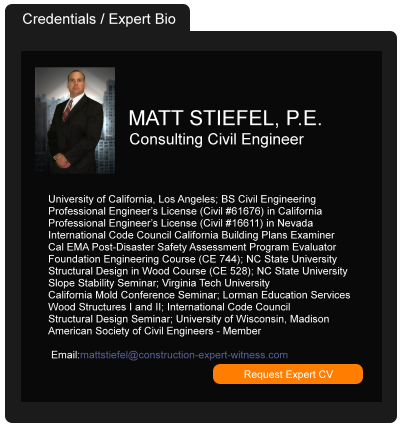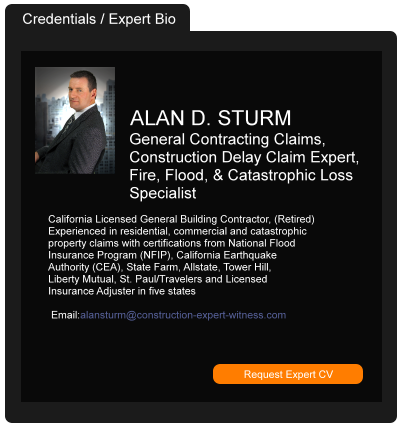A UK Bridge That Is a Lesson on How to Build Infrastructure
November 15, 2017 —
Cameron J. Bell - Engineering News-RecordThis country’s infrastructure—bridges, airports, dams and levees—needs wide-scale repair and renewal. The United Kingdom’s new Queensferry Crossing bridge, connecting Edinburgh to Fife in Scotland, sets a new standard for how to do it. The result speaks for itself: The Queensferry Crossing, a three-tower, 1.7-mile-long cable-stayed bridge, debuted in early September well within budget and a manageable eight-month time delay—a rare occurrence among bridges. According to research at the University of Oxford’s Saïd Business School, nine out of 10 fixed links (bridges and tunnels) suffer an average cost overrun of 34% and a time delay of roughly two years.
Read the court decisionRead the full story...Reprinted courtesy of
Cameron J. Bell, ENR ENR may be contacted at
ENR.com@bnpmedia.com
Whose Employee is it Anyway?: Federal Court Finds No Coverage for Injured Subcontractor's Claim Based on Modified Employer's Liability Exclusion
September 28, 2020 —
Jeffrey J. Vita & Kerianne E. Kane - Saxe Doernberger & VitaIn Nagog Real Estate Consulting Corp. v. Nautilus Insurance Co.,1 the United States District Court for the District of Massachusetts held that an insurer had no duty to defend its insureds against claims brought by an injured subcontractor, based on an overbroad employer’s liability exclusion in the policy.
Nautilus Insurance Company issued a commercial general liability policy to developer Nagog Homes LLC and its related construction company, Nagog Real Estate. The policy was endorsed with an Employer’s Liability Exclusion (the L205 Endorsement) that expanded the scope of the standard exclusion in the coverage form to include bodily injury claims of employees of “any” insured and their contractors or subcontractors, as opposed to simply the employees of the named insured.
Nagog Homes was the developer, and Nagog Real Estate was the general contractor for a residential construction project. An employee of the framing subcontractor hired by Nagog Real Estate was injured while working on the project and sued both Nagog entities for his injuries. Nautilus, relying on the modified employer’s liability exclusion, denied coverage for the lawsuit based on allegations that the Nagog entities hired the framing subcontractor to perform work, which effectively made the plaintiff an employee of one or both of the Nagog entities.
Reprinted courtesy of
Jeffrey J. Vita , Saxe Doernberger & Vita and
Kerianne E. Kane, Saxe Doernberger & Vita
Mr. Vita may be contacted at jjv@sdvlaw.com
Ms. Kane may be contacted at kek@sdvlaw.com
Read the court decisionRead the full story...Reprinted courtesy of
Claim for Consequential Damages Survives Motion to Dismiss
November 14, 2018 —
Tred R. Eyerly - Insurance Law HawaiiThe insured's claim for consequential damages survived the insurer's motion to dismiss. Tiffany Tower Condominium, LLC v. Ins. Co. of the Greater N.Y., 2018 N.Y. App. Div. LEXIS 5783 (N.Y. App. Div. Aug. 22, 2018).
Tiffany Tower submitted a claim in November 2012 with Insurance Company of the Great New York for damages sustained by its building during Superstorm Sandy. The insurer paid the original claim in December 2012. Then, in September 2014, Tiffany Tower submitted a supplemental claim for additional losses which it asserted were caused by the storm. The insurer denied the supplemental claim.
Read the court decisionRead the full story...Reprinted courtesy of
Tred R. Eyerly, Damon Key Leong Kupchak HastertMr. Eyerly may be contacted at
te@hawaiilawyer.com
Former Superintendent Sentenced in Rhode Island Tainted Fill Case
July 05, 2023 —
James Leggate - Engineering News-RecordA federal judge sentenced a contractor’s former superintendent June 20 for misleading officials about the source of fill and quality of contaminated fill used on the $410 million Route 6/10 interchange project in Rhode Island.
Reprinted courtesy of
James Leggate, Engineering News-Record
Mr. Leggate may be contacted at leggatej@enr.com
Read the full story... Read the court decisionRead the full story...Reprinted courtesy of
Court Affirms Summary Adjudication of Bad Faith Claim Where Expert Opinions Raised a Genuine Dispute
July 06, 2020 —
Christopher Kendrick & Valerie A. Moore – Haight Brown & Bonesteel LLPIn 501 East 51st Street etc. v. Kookmin Best Ins. Co., Ltd. (No. B293605, filed 4/2/20, ordered pub. 4/16/20), a California appeals court affirmed summary adjudication and dismissal of a bad faith claim based on the genuine dispute doctrine.
501 East 51st Street Long-Beach-10, LLC (501) was the owner of a 10-unit apartment complex, insured by Kookmin Best. In 2017, an underground water main alongside the building burst which, according to 501, caused the building to move and crack. 501 made a claim and supplied a geotechnical report finding cracks in the foundation walls, cracks in the stucco and significant floor deformation and tilting near the water leak. The engineer’s opinion concluded that that “existing building distress was substantially contributed to by the water main break. The water introduced to the soil medium appears to have triggered differential foundation movement causing the stress features to develop.”
Kookmin retained its own engineers to investigate, who returned an opinion that the leak had exacerbated long-term pre-existing settlement which would continue. Under the policy, damage to the building caused by earth movement and settlement were excluded, but water damage resulting from an “accidental discharge” of water was covered. Kookmin then obtained an opinion from coverage counsel, who opined that only damage allocable to the water leak would be covered.
Reprinted courtesy of
Christopher Kendrick, Haight Brown & Bonesteel LLP and
Valerie A. Moore, Haight Brown & Bonesteel LLP
Mr. Kendrick may be contacted at ckendrick@hbblaw.com
Ms. Moore may be contacted at vmoore@hbblaw.com
Read the court decisionRead the full story...Reprinted courtesy of
Decaying U.S. Roads Attract Funds From KKR to DoubleLine
January 28, 2015 —
Romy Varghese and Mark Niquette – Bloomberg(Bloomberg) -- Investors such as Jeffrey Gundlach’s DoubleLine Capital and KKR & Co. are looking at crumbling U.S. roads -- and like what they see.
DoubleLine, which oversees $64 billion, plans to start its first fund to finance infrastructure, Gundlach said this month. KKR, the private-equity firm led by Henry Kravis and George Roberts, signed a contract in December to manage the water system in Middletown, Pennsylvania, with Suez Environnement Co.’s United Water unit. Its debut infrastructure fund started buying assets in 2011, Bloomberg News reported in April.
The companies are partnering with states and localities fed up with federal inaction to jump-start transit projects and revamp public works suffering from decades of neglect. Such an alliance in Pennsylvania, home to the nation’s highest number of deficient bridges, is letting the state replace 558 crossings more cheaply and more quickly.
Reprinted courtesy of
Romy Varghese, Bloomberg and
Mark Niquette, Bloomberg
Ms. Varghese may be contacted at rvarghese8@bloomberg.net; Mr. Niquette may be contacted at mniquette@bloomberg.net
Read the court decisionRead the full story...Reprinted courtesy of
Just Because I May Be An “Expert” Does Not Mean I Am Giving Expert Testimony
January 17, 2022 —
David Adelstein - Florida Construction Legal UpdatesOn a construction project, it’s hard to argue that the involved parties — whether an architect, engineer, contractor, subcontractor, developer, etc. — are not experts in their field, i.e., they all some scientific, technical, or specialized knowledge or skill particular to their industry. However, this does NOT mean when they testify in trial, at an arbitration, or at a deposition regarding the construction project they are offering expert opinions / testimony as it pertains to that project. Testifying as to facts based on personal knowledge or involvement on a project makes you a fact witness and is different than evaluating and rending an after-the-fact opinion as to the work of others. This does not minimize your knowledge or expertise; it simply means that relative to the construction project you are involved with, your testimony is that of a fact witness and not of an expert. (It is possible to wear both the fact witness and expert witness hat, but that depends on your subsequent role in the litigation or arbitration.)
Read the court decisionRead the full story...Reprinted courtesy of
David Adelstein, Kirwin Norris, P.A.Mr. Adelstein may be contacted at
dma@kirwinnorris.com
Quick Note: Be Careful with Pay if Paid Clauses (Both Subcontractors and General Contractors)
October 12, 2020 —
Christopher G. Hill - Construction Law MusingsAside from waiver of lien rights (something that will be illegal in Virginia after July 1, 2015), the most troublesome contractual impediment to payment for a subcontractor or supplier on a project often is the “pay if paid” clause. As a general rule, in Virginia, these clauses where drafted in the proper fashion, are enforceable. As I have said many times, in Virginia freedom of contract almost always wins out.
While this is the case, I emphasize that such clauses must be very explicit and specific. Furthermore, and in something that should be obvious, these clauses are generally limited by the Courts of Virginia to only be enforceable and to only forgive the need for payment if the upstream contractor on the construction job has not been paid for the work that the sub claiming non payment has done.
Read the court decisionRead the full story...Reprinted courtesy of
The Law Office of Christopher G. HillMr. Hill may be contacted at
chrisghill@constructionlawva.com


































































